2020 MASERATI GRANTURISMO CONVERTIBLE warning
[x] Cancel search: warningPage 96 of 296
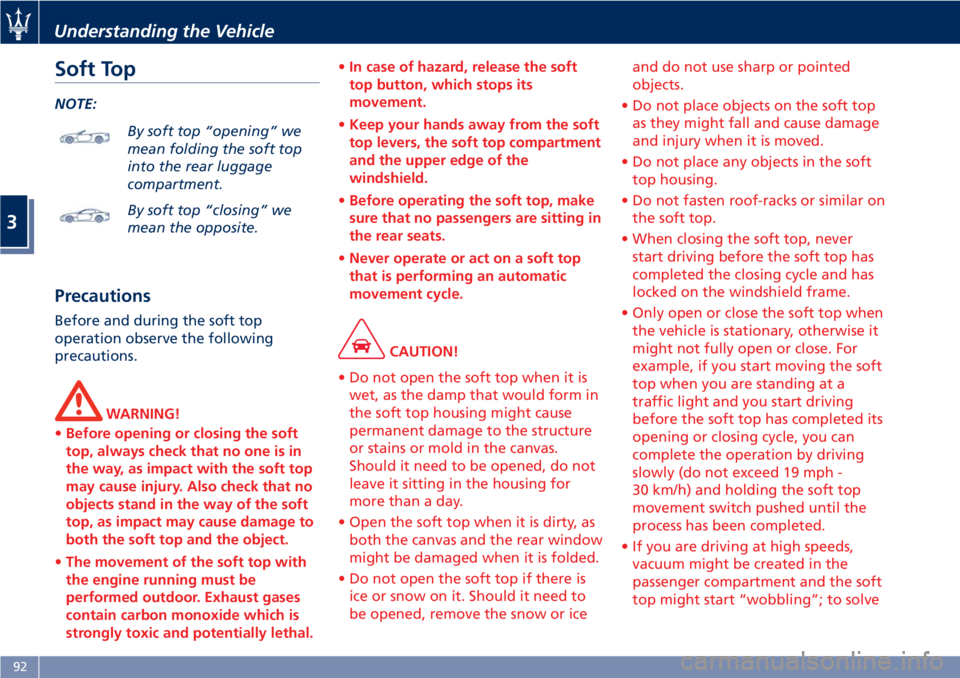
Soft Top
NOTE:
By soft top “opening” we
mean folding the soft top
into the rear luggage
compartment.
By soft top “closing” we
mean the opposite.
Precautions
Before and during the soft top
operation observe the following
precautions.
WARNING!
•Before opening or closing the soft
top, always check that no one is in
the way, as impact with the soft top
may cause injury. Also check that no
objects stand in the way of the soft
top, as impact may cause damage to
both the soft top and the object.
•The movement of the soft top with
the engine running must be
performed outdoor. Exhaust gases
contain carbon monoxide which is
strongly toxic and potentially lethal.•In case of hazard, release the soft
top button, which stops its
movement.
•Keep your hands away from the soft
top levers, the soft top compartment
and the upper edge of the
windshield.
•Before operating the soft top, make
sure that no passengers are sitting in
the rear seats.
•Never operate or act on a soft top
that is performing an automatic
movement cycle.
CAUTION!
• Do not open the soft top when it is
wet, as the damp that would form in
the soft top housing might cause
permanent damage to the structure
or stains or mold in the canvas.
Should it need to be opened, do not
leave it sitting in the housing for
more than a day.
• Open the soft top when it is dirty, as
both the canvas and the rear window
might be damaged when it is folded.
• Do not open the soft top if there is
ice or snow on it. Should it need to
be opened, remove the snow or iceand do not use sharp or pointed
objects.
• Do not place objects on the soft top
as they might fall and cause damage
and injury when it is moved.
• Do not place any objects in the soft
top housing.
• Do not fasten roof-racks or similar on
the soft top.
• When closing the soft top, never
start driving before the soft top has
completed the closing cycle and has
locked on the windshield frame.
• Only open or close the soft top when
the vehicle is stationary, otherwise it
might not fully open or close. For
example, if you start moving the soft
top when you are standing at a
traffic light and you start driving
before the soft top has completed its
opening or closing cycle, you can
complete the operation by driving
slowly (do not exceed 19 mph -
30 km/h) and holding the soft top
movement switch pushed until the
process has been completed.
• If you are driving at high speeds,
vacuum might be created in the
passenger compartment and the soft
top might start “wobbling”; to solve
Understanding the Vehicle
3
92
Page 101 of 296
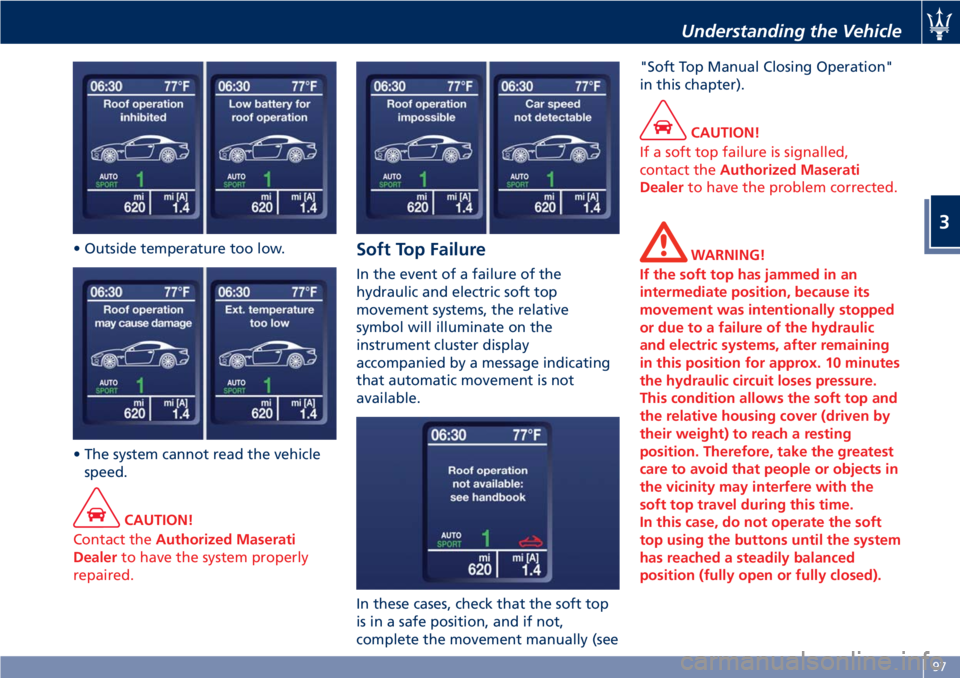
• Outside temperature too low.
• The system cannot read the vehicle
speed.
CAUTION!
Contact theAuthorized Maserati
Dealerto have the system properly
repaired.
Soft Top Failure
In the event of a failure of the
hydraulic and electric soft top
movement systems, the relative
symbol will illuminate on the
instrument cluster display
accompanied by a message indicating
that automatic movement is not
available.
In these cases, check that the soft top
is in a safe position, and if not,
complete the movement manually (see"Soft Top Manual Closing Operation"
in this chapter).
CAUTION!
If a soft top failure is signalled,
contact theAuthorized Maserati
Dealerto have the problem corrected.
WARNING!
If the soft top has jammed in an
intermediate position, because its
movement was intentionally stopped
or due to a failure of the hydraulic
and electric systems, after remaining
in this position for approx. 10 minutes
the hydraulic circuit loses pressure.
This condition allows the soft top and
the relative housing cover (driven by
their weight) to reach a resting
position. Therefore, take the greatest
care to avoid that people or objects in
the vicinity may interfere with the
soft top travel during this time.
In this case, do not operate the soft
top using the buttons until the system
has reached a steadily balanced
position (fully open or fully closed).
Understanding the Vehicle
3
97
Page 102 of 296

NOTE:
The soft top failure temporarily
disables, for approx. 10 minutes, the
power windows’ operation. After this
time, the power windows will resume
normal functioning.
Soft Top Manual Closing
Operation
In case of need, the soft top may be
closed manually.
WARNING!
•Manual operation of the soft top for
emergency closing requires the
presence of two persons in order to
prevent personal injury or damage
to the car.
•When moving the soft top by hand,
take the greatest care as its movable
parts could squeeze or trap objects
or parts of your body.
CAUTION!
The emergency procedure described
below must be used to close the soft
top if it is not possible for you to
contact theAuthorized Maserati
Dealerimmediately and you cannot
keep the soft top open.
If the failure occurs when the opening
procedure is already in progress, do
not attempt to complete the
procedure - close back the soft top
manually according to the following
instructions. After depressurizing the
hydraulic circuit by turning the key in
the ignition switch toSTOP (OFF)
position, perform the emergency
procedure starting from the point at
which the opening stage jammed.
WARNING!
After depressurizing the system, the
soft top will move freely. Therefore, if
it is not in a balanced position, it will
close or open as a consequence of its
weight. Take the greatest care to
avoid being squeezed or trapped by
its levers and mechanisms.
Before Starting
NOTE:
•During emergency closing, the side
windows must be lowered.
•
To move the soft top manually, you
must depressurize the hydraulic system
by turning the key in the ignition
switch to
STOP (OFF)position and
waiting approx. 10 minutes.•To avoid unintentional activations,
we recommend that you remove the
key from the ignition switch. Take
the flat-head screwdriver and the
wrench to lock/unlock the soft top
hinges out of the tool kit located in
the trunk compartment (see "Tool
Kit" in section "In an Emergency").
Soft Top Closing
• Using a flat head screwdriver, remove
the access covers (housed on both
sides of the compartment) turning
the relative fastening screws
counterclockwise by a quarter of a
turn.
• Reach the small cables through the
slots and pull them to unlock the soft
top cover locks.
• Reassemble the access covers and
lock them turning the following
screw clockwise.
Understanding the Vehicle
3
98
Page 104 of 296

• Turn the wrench clockwise to move
the soft top edge closer to the
windshield, and fasten the fastening
latches inside the locks.
• Remove the unlocking/locking
wrench from the soft top seat and
place it in the tool kit box together
with the screwdriver.Windstop (optional)
The Windstop consists of a panel fitted
behind the front seats, which prevents
the wind from creating turbulence in
the passenger compartment when the
soft top is open. The Windstop can
also be left installed with soft top
closed.
WARNING!
With Windstop installed you can not
carry passengers in the rear seats.
The Windstop is normally stored in a
protective bag inside the trunk
compartment.
This bag is secured inside the
compartment by means of a strap.
CAUTION!
• It is recommended not to place sharp
and pointed objects which may
contact the protective bag in the
trunk compartment, unless they are
firmly secured.
• You should not place objects on the
Windstop protective bag, even if
they are secured, as they maydamage the Windstop with their
weight.
NOTE:
If the vehicle is equipped with spare
wheel (optional), it may not house in
the trunk compartment the Windstop
inside its bag.
Fitting the Windstop
• Take the Windstop out of its bag.
• Turn the lower left-hand part, until it
is fully laid out.
• Join the rear section to the base of
the Windstop.
Understanding the Vehicle
3
100
Page 107 of 296
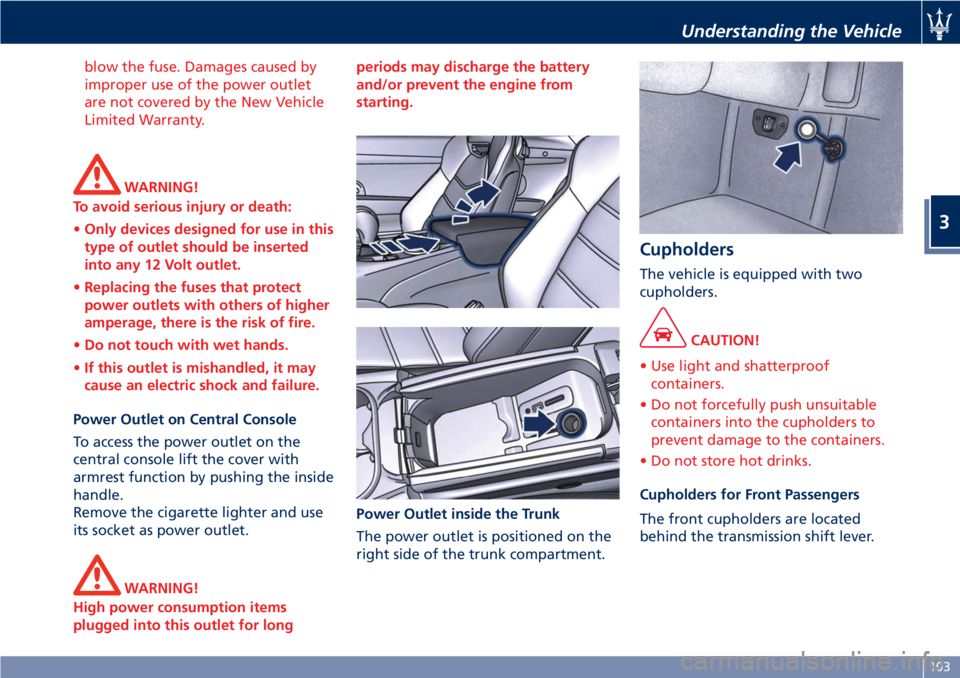
blow the fuse. Damages caused by
improper use of the power outlet
are not covered by the New Vehicle
Limited Warranty.
WARNING!
To avoid serious injury or death:
•Only devices designed for use in this
type of outlet should be inserted
into any 12 Volt outlet.
•Replacing the fuses that protect
power outlets with others of higher
amperage, there is the risk of fire.
•Do not touch with wet hands.
•If this outlet is mishandled, it may
cause an electric shock and failure.
Power Outlet on Central Console
To access the power outlet on the
central console lift the cover with
armrest function by pushing the inside
handle.
Remove the cigarette lighter and use
its socket as power outlet.
WARNING!
High power consumption items
plugged into this outlet for longperiods may discharge the battery
and/or prevent the engine from
starting.
Power Outlet inside the Trunk
The power outlet is positioned on the
right side of the trunk compartment.
Cupholders
The vehicle is equipped with two
cupholders.
CAUTION!
• Use light and shatterproof
containers.
• Do not forcefully push unsuitable
containers into the cupholders to
prevent damage to the containers.
• Do not store hot drinks.
Cupholders for Front Passengers
The front cupholders are located
behind the transmission shift lever.
Understanding the Vehicle
3
103
Page 110 of 296
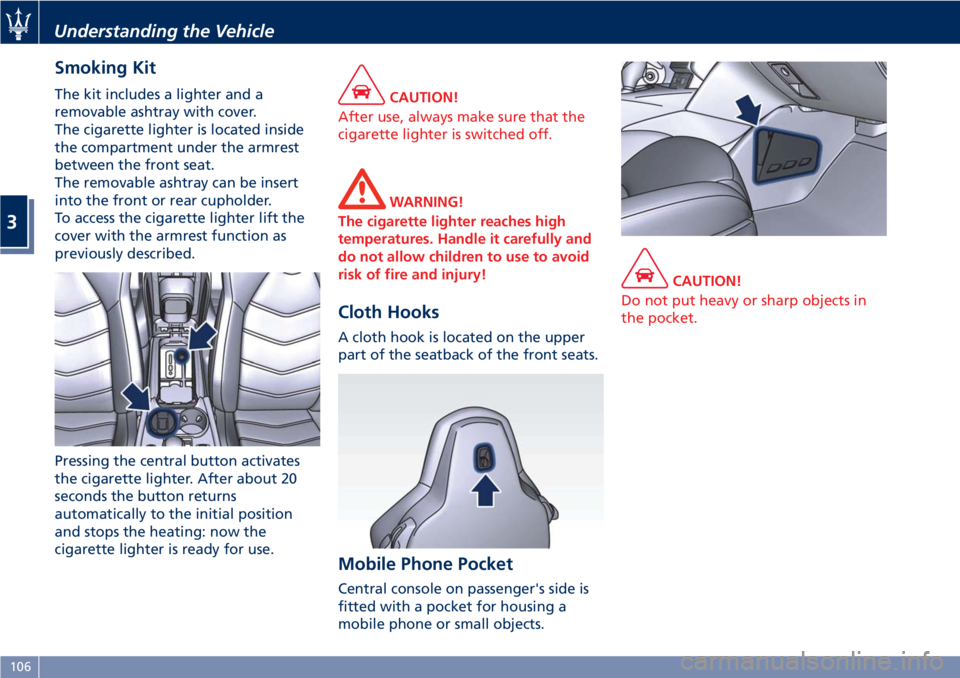
Smoking Kit
The kit includes a lighter and a
removable ashtray with cover.
The cigarette lighter is located inside
the compartment under the armrest
between the front seat.
The removable ashtray can be insert
into the front or rear cupholder.
To access the cigarette lighter lift the
cover with the armrest function as
previously described.
Pressing the central button activates
the cigarette lighter. After about 20
seconds the button returns
automatically to the initial position
and stops the heating: now the
cigarette lighter is ready for use.CAUTION!
After use, always make sure that the
cigarette lighter is switched off.
WARNING!
The cigarette lighter reaches high
temperatures. Handle it carefully and
do not allow children to use to avoid
risk of fire and injury!
Cloth Hooks
A cloth hook is located on the upper
part of the seatback of the front seats.
Mobile Phone Pocket
Central console on passenger's side is
fitted with a pocket for housing a
mobile phone or small objects.
CAUTION!
Do not put heavy or sharp objects in
the pocket.
Understanding the Vehicle
3
106
Page 111 of 296
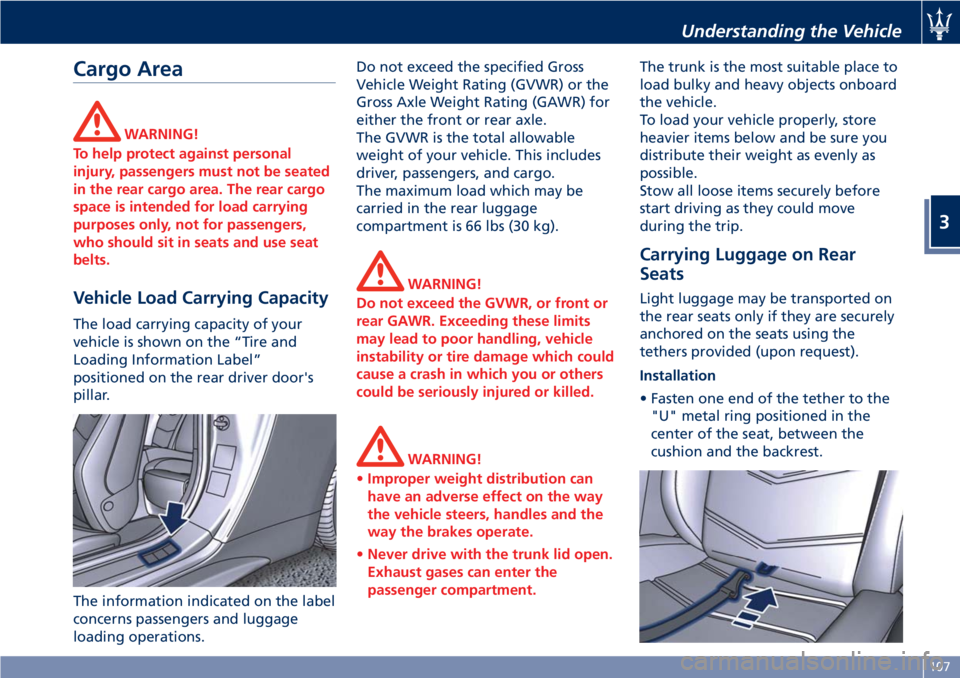
Cargo Area
WARNING!
To help protect against personal
injury, passengers must not be seated
in the rear cargo area. The rear cargo
space is intended for load carrying
purposes only, not for passengers,
who should sit in seats and use seat
belts.
Vehicle Load Carrying Capacity
The load carrying capacity of your
vehicle is shown on the “Tire and
Loading Information Label”
positioned on the rear driver door's
pillar.
The information indicated on the label
concerns passengers and luggage
loading operations.Do not exceed the specified Gross
Vehicle Weight Rating (GVWR) or the
Gross Axle Weight Rating (GAWR) for
either the front or rear axle.
The GVWR is the total allowable
weight of your vehicle. This includes
driver, passengers, and cargo.
The maximum load which may be
carried in the rear luggage
compartment is 66 lbs (30 kg).
WARNING!
Do not exceed the GVWR, or front or
rear GAWR. Exceeding these limits
may lead to poor handling, vehicle
instability or tire damage which could
cause a crash in which you or others
could be seriously injured or killed.
WARNING!
•Improper weight distribution can
have an adverse effect on the way
the vehicle steers, handles and the
way the brakes operate.
•Never drive with the trunk lid open.
Exhaust gases can enter the
passenger compartment.
The trunk is the most suitable place to
load bulky and heavy objects onboard
the vehicle.
To load your vehicle properly, store
heavier items below and be sure you
distribute their weight as evenly as
possible.
Stow all loose items securely before
start driving as they could move
during the trip.
Carrying Luggage on Rear
Seats
Light luggage may be transported on
the rear seats only if they are securely
anchored on the seats using the
tethers provided (upon request).
Installation
• Fasten one end of the tether to the
"U" metal ring positioned in the
center of the seat, between the
cushion and the backrest.
Understanding the Vehicle
3
107
Page 113 of 296

WARNING!
Vehicle exhaust contains carbon
monoxide, a dangerous gas. Do not
run your vehicle in the garage while
programming the transceiver. Exhaust
gas can cause serious injury or death.
Customer Service
If you have problems with training the
HomeLink Universal Transceiver, or
would like information on home
products that can be operated by the
transmitter, call (800) 355-3515. On the
Internet, go to www.Homelink.com.
Safety Precautions
Always refer to the operating
instructions and safety information
that came with your garage door
opener or other equipment you
intend to operate with the HomeLink
Universal Transceiver. If you do not
have this information, you should
contact the manufacturer of the
equipment.
While training or using HomeLink,
make sure you have a clear view of
the garage door or gate, and that no
one will be injured by its movement.
General Information
While programming HomeLink®,itis
advisable to disconnect the drive
motor of the gate/door to be remote
controlled, since the numerous driving
pulses launched for this operation
might damage it.
If the battery fails or is disconnected,
the stored settings are not deleted.
If the gate/door was manufactured
prior to April 1982 (not equipped with
safety systems or automatic stop in the
event of an obstacle in the range of
action), the gate/door cannot be
controlled by HomeLink
®.
If you have questions, call (800)
355-3515.
WARNING!
California Proposition 65
Operating, servicing and maintaining
a passenger vehicle or off-road vehicle
can expose you to chemicals including
such as, engine exhaust, carbon
monoxide, phthalates and lead, that
which are know to the State of
California to cause cancer and birth
defects or other reproductive harm. To
minimize exposure, avoid breathing
exhaust, do not idle the engine except
as necessary, service your vehicle in awell-ventilated area and wear gloves
or wash your hands frequently when
servicing your vehicle. For more
information go to:
www.P65Warnings.ca.gov/passenger-
vehicle
Programming
• Press and hold buttons "1" and "3".
• After about 20 seconds, the LED
starts flashing.
• Release the buttons.
• Hold the remote control for the
device to be controlled close to the
HomeLink
®control panel (0-30 cm/
0-12 in).
• Simultaneously press and hold the
button on the hand-held remote
control and one of the three
HomeLink
®buttons "1", "2" or "3".
• Successful programming is signaled
by the LED flashing faster.
• Release the buttons.
To program the other buttons, repeat
the operations skipping the first three
steps.
Understanding the Vehicle
3
109